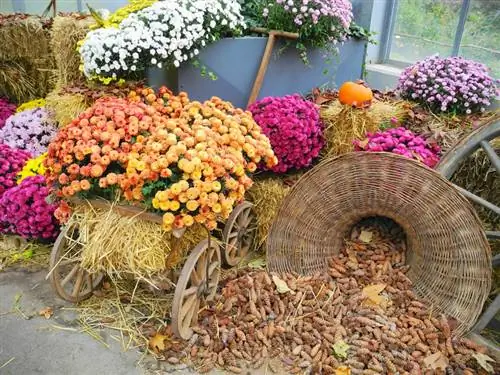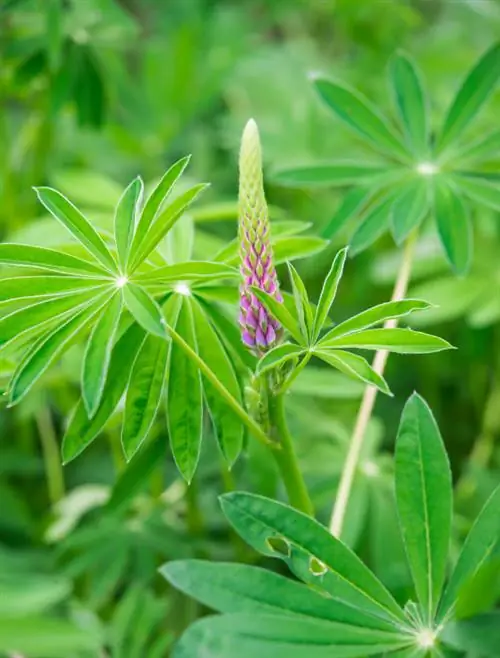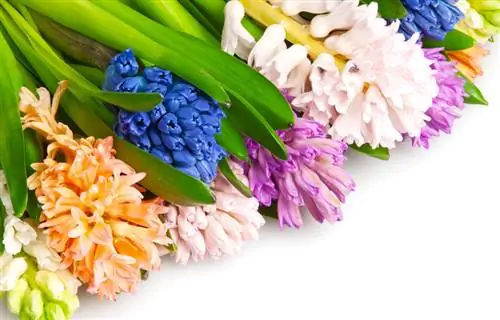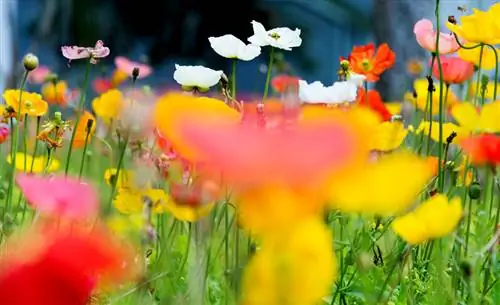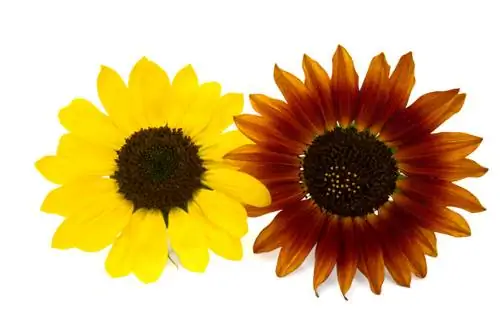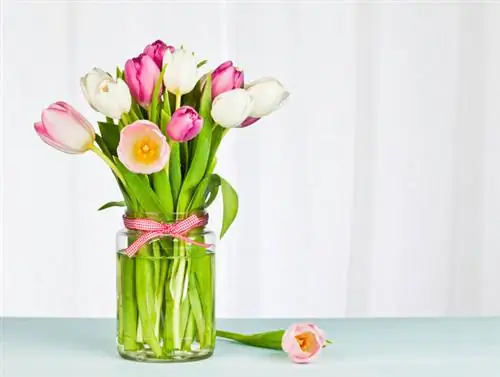- Author admin [email protected].
- Public 2023-12-25 17:45.
- Last modified 2025-01-23 11:20.
With colorful ray flowers and yellow tubular flowers, asters form distinctive flower heads that decorate the garden and balcony all year round. From the hardy spring aster to the annual summer aster to the perennial autumn aster, the multi-faceted genus fulfills every design wish. The following answers to frequently asked questions reveal how cultivation goes smoothly across the garden stage.

How do I properly care for asters in the garden?
Asters are easy-care, perennial flowering plants that bloom from spring to autumn, depending on the variety. They prefer sunny locations, well-drained soil and regular watering. Planting in spring is ideal, as is regular fertilization, pruning and, if necessary, winter protection.
Planting aster correctly
Plant your asters in spring. Long-term practice has shown that autumn planting is associated with high losses. Plant the young plants grown behind glass or purchased ready-made so deeply into the soil that the root ball is just below the surface. The addition of compost, horn shavings or leaf mold promotes rooting naturally. The alpine and mountain asters, on the other hand, are happy about the addition of fine grit or sand as well as some rock dust for a vital start to the life of the perennials. Water regularly on the day of planting and thereafter.
Care tips
Our heads are quickly spinning at the overwhelming variety of species and varieties that the wonderful genus of asters presents us with. How good that there is widespread conformity when it comes to care. With these donations you can guide the perennials through the gardening year:
- If it is dry, pour directly onto the root slice
- During the growth and flowering period, fertilize organically or give phosphorus-rich liquid fertilizer
- Consistently clean out withered flowers
- Record and share every 2-3 years
- Rake and weed regularly to keep the soil loose
Before the first frost, cut the perennials by a maximum of a third, unless self-sowing is planned. A thick layer of leaves or compost effectively prevents winter damage. Asters in planters ideally move to a frost-free winter quarters.
Which location is suitable?
The selected variety defines the framework conditions for the ideal location. We have put together the following brief overview of popular aster species and varieties:
- Alpine aster (Aster alpinus): Sunny to partially shaded in dry, lean, alkaline to neutral soil
- Mountain aster/lime aster (Aster amellus): Sunny to partially shaded, in calcareous, sandy-lean, dry soil
- Cushion aster (Aster dumosus) and smooth-leaf aster (Aster novi-belgii): Sunny, airy, nutrient-rich, fresh, moist soil
- Summer aster (Callistephus chinensis): Sunny, well-drained, humus-rich, moderately moist soil
- Autumn Aster/Smooth Aster (Aster laevis): Sunny location with loamy, poor, not too dry soil
- Raublatt-Aster (Aster novae-angliae): Sunny to shady with nutritious, humus-rich, slightly moist soil
Although the requirements for light, temperature and soil conditions differ, asters agree on one thing: they cannot stand waterlogging.
The correct planting distance
Adjust the planting distance to the selected aster variety. Cushion asters that remain small come into their own wonderfully at a distance of 20-25 cm. Medium-sized species are positioned at a distance of 40-45 cm. The majestic wood asters, smooth asters, or myrtle asters should be planted at a distance of 50-60 cm.
What is the best time to plant?
In gardening practice, spring planting has proven to be excellent for asters. This applies across the entire species spectrum. For the cold-sensitive summer asters, this date is a must anyway. In this way, the perennials have enough time to establish themselves so well that winter cannot harm them.
When is flowering time?
Where asters thrive in the garden, there is a colorful blossom festival all year round. The prerequisite for never-ending basket flowers is the right combination of species and varieties. For your inspiration, we have put together some popular species with flowering times for you:
- Alpine aster (Aster alpinum): flowering period from May to July
- Wild aster (Aster ageratoides): flowering period from July to October
- Forest aster (Aster cordifolius) and rough-leaf aster (Aster novae-angliae): flowering period from August to October
- Cushion Aster (Aster dumosus): flowering period from September to December
While the species mentioned above show off their blooms every year, the summer aster (Callistephus chinensis) is limited to a one-off appearance on the garden stage from July to September.
Cut aster correctly
If you cut off withered flower heads during the flowering period, the buds underneath will happily accept this invitation to develop. Your effort will be rewarded with a long-lasting bloom and a well-groomed appearance. However, please only carry out pruning close to the ground at the end of the winter period. Until then, the plant parts that have been pulled in act as natural winter protection. If self-sowing is not desired, cut the plants back by a third in autumn.
Watering aster
Please only water the drought-loving alpine and mountain asters when the soil has dried to a depth of 3-4 cm. All other garden asters like a constantly slightly moist soil, regardless of whether the bed or the balcony box is their home. Since the flowers are all lime-tolerant, you can use normal tap water. Please avoid watering your favorite flowers overhead and instead pour the water from the can nozzle directly onto the root disk.
Fertilize Aster properly
With an organic nutrient supply, you provide all types of asters with the nutrition they need for a long flowering period and avoid the risk of over-fertilization. Adjust the time for adding compost, horn shavings, guano or bark humus to the individual start of the growth phase. Until the end of the flowering period, work the material lightly into the soil with a rake every 3-4 weeks and then water. The lime-loving mountain and alpine asters also receive a handful of rock powder or algae lime. For asters in pots and balcony boxes, we recommend an organic-mineral, phosphorus-concentrated liquid fertilizer according to the manufacturer's instructions.
Diseases
Fusarium wilt, which is common in kitchen and ornamental gardens, does not stop at asters. The penetrant ascomycete genus causes stems, leaves and flowers to die. If symptoms appear, such as wilted, spotty leaves that die from the ground, dig up the affected plants and dispose of them with household waste. In the following 3-4 years, composite plants should no longer be cultivated at this location.
Wintering
The majority of garden asters are hardy and stand up to the floral challenges of even bitter frost. In exposed locations and to protect against constant moisture, we still recommend these precautions:
- Cut the plants back by a maximum of a third in autumn
- Hill up the bed with leaf mold or cover with conifers
- Place asters in the pot in a frost-free winter quarters
The annual summer asters are an exception. Not least because of their short lifespan, they have recently formed their own genus as Callistephus chinensis. If the summer flowering period is coming to an end, dig up the root balls to dispose of them in the compost.
Propagate Aster
If you can't get enough of the flowering and easy-care asters, choose from the following propagation methods:
- Sowing the seeds on the windowsill, with a germination time of 2-4 weeks at 18-20 degrees Celsius
- Dividing the root ball in spring or autumn
- Cut cuttings during the growing season and let them root in poor soil
Asters grown behind glass start the season with a significant growth lead. If the seeds are harvested by yourself, the color of the flowers is always a surprise. On the other hand, with vegetative propagation through division or cuttings, you are sure to achieve a pure result.
How do I transplant correctly?
Every 2-3 years, the perennials should be picked up in spring, divided and planted in the new location. Thanks to this rejuvenation treatment, your asters will remain vital and blooming. At the same time, these measures ensure uncomplicated propagation. As long as a section has at least 2 shoots, it has the growth potential to become an adult aster.
Aster in pot
The cultivation of asters in pots will be rich in flowers if you treat the flowers to high-quality pot plant soil enriched with lava granules or perlite breathing flakes. Please do not forget to place some pottery shards over the water drain to protect against waterlogging. The care program in the bucket and balcony box is just as uncomplicated as in the bed:
- If the substrate surface dries, it is poured directly onto the root disc
- Fertilize liquidly every 2 weeks from the start of growth until the end of the flowering period
- Continuously clean out wilted flower heads
In autumn, cut the perennial back by a third. Then move the pot to the frost-free winter quarters. During dormant growth, water only moderately and do not give any fertilizer. In March/April, cut off the remaining leaves and repot the perennial into fresh substrate. From the end of April/beginning of May the aster takes its usual place on the balcony and terrace.read more
Is aster poisonous?
Asters are the ideal ornamental perennials for the family garden and balcony. There are no poisonous specimens within the wide range of species and varieties. On the contrary, the flowers act as a colorful decoration for cold and warm dishes in creative cuisine. Of course, this only applies to plants grown organically.
Beautiful varieties
- Albus: White Alpine aster, with its flower decorations spring arrives in the rock garden and on the balcony; 25cm
- Wartburg Star: Light purple, rather short-lived pre-summer aster that exudes a wonderful scent; 40-50cm
- Mira: Richly blooming summer aster that delights us with blue-violet flowers from July to September; 40-45cm
- Opus: Annual summer aster, Callistephus chinensis, with purple-white, paeonium-like flowers; 70-80cm
- Little Carlow: Hardy blue wood aster with dark blue flowers from August to November; 70-110cm
- Alma Pötschke: Fantastically beautiful autumn aster with salmon pink flowers as ideal fence peepers; 120-140cm
- Eye-candy: Lush cushion aster for reddish-purple flower cushions from September to December; 20-25cm
- Autumn Greetings from Bresserhof: Award-winning, pink-red cushion aster until the first frost; 30-40cm
- Snow Grid: Magnificent myrtle aster with countless white flowers on loose panicles in autumn; 70-90cm
- Calliope: Majestic, quite late autumn aster, richly branched with light purple flowers from October; 120-140cm

